I have various images of naval gun projects. I'll add them here as I scan them. Unless here is moved to a somewhere else. 
RP1
RP1
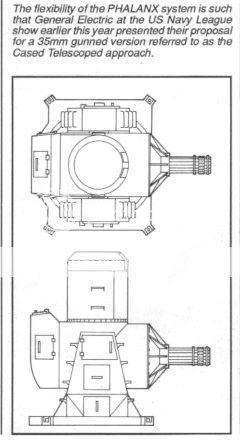
RP1 said:First up, a 35mm CIWS proposal presented at the 1991 US Navy League show.

Source: Navy International, November 1991, Vol 96, No 11, Publ: Maritime World Limited
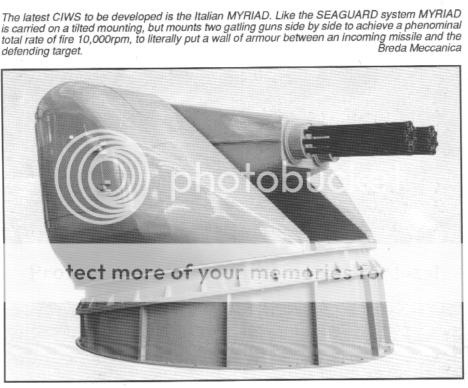
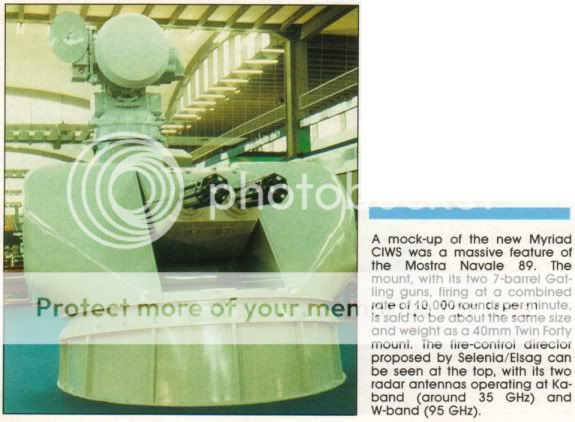
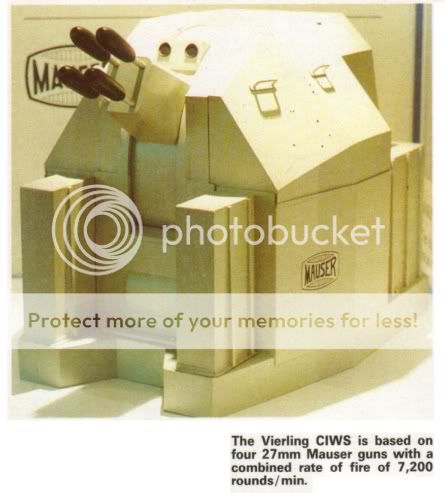
"Vulcan" CIWS is still the industry standard in the West
It has bugged me for years

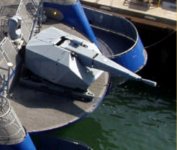
MDG-351 35-mm Millennium Gun
In March 2002 Lockheed Martin, Akron, Ohio, and Oerlikon Contraves, Zurich, Switzerland, joined forces to produce and market the rapid-fire Millennium Gun. The Millennium Gun is the only multi-mission close-in weapon system capable of engaging fast-attack surface craft and near-shore land targets in littoral and riverine waters, as well as defending against anti-ship missiles and aircraft in all environments.
The gun's highly effective inner layer defense capability extends ship self-protection to ranges greater than any other close-in weapon systems. Creating a "wall of steel," the Millennium Gun fires 35-mm ammunition, including the advanced Ahead round, at 1,000 rounds per minute. Each Ahead round dispenses 152 subprojectiles that form a cone-shaped pattern. The subprojectiles destroy a target's control surfaces, seeker and other vital components as it moves through the wall of steel.
The Millennium Gun is a low-cost, unmanned, remotely controlled gun mount. It is compatible with all modern and legacy sensors and fire control systems. It fits on a number of ship classes, including such advanced designs as the U.S. Coast Guard National Security Cutter and the Littoral Combat Ship. Oerlikon Contraves has received expressions of interest from several navies for mounts on frigates and corvettes.
The Millennium Gun will give navies a multimission-capable deck gun, defending against sea-skimming cruise missiles and other air threats in the open ocean and against the asymmetric threat of small surface craft in littoral and riverine waters.
The gun's kill radius varies according to the type of threat it engages. Testing has shown it to be lethal against aircraft and helicopters at 3.5 km, against cruise missiles at 2 km, and against anti-ship sea-skimming missiles at 1.5 km. These distances extend the close-in defensive perimeter and the time available for a ship to engage and destroy an imminent threat
The Millennium Gun's versatility and modularity was demonstrated during the U.S. Navy's Fleet Battle Experiment-Juliet, scheduled for July and August 2002. Lockheed Martin's Sea SLICE, an advanced technology demonstrator vessel participating in the exercise, was fitted with the Millennium Gun on its bow. The exercise highlighted the gun's adaptability to fit on a number of ship classes. Its low weight, small footprint and easy loading of ammunition make it ideal for new ship construction and existing ships earmarked for modernization.
I'm not sure it will!more naval material could shed light on DACR
1 Myriad CIWS
1.1 History and development background
To meet the threat from the next generation of high-speed manoeuvring anti-ship missiles, Oerlikon began to examine a Gatling principle gun and in 1984 developed a six-barrel prototype.
The company continued this work and in 1988, developed the seven barrel KBD 5000 (later Breda-Oerlikon KBD or Barrage) which was selected by an Italian consortium as the basis for a new CIWS system, Myriad.
This system was revealed at Mostra Navale in May 1989 when a mock-up of the system was displayed.
1.2 Technical description
The purpose of the Myriad system is to predict the area which a missile or missiles had to travel, saturating that area with projectiles in order to ensure the destruction of the target.
These objectives is met by means of a system which used twin 25 mm calibre Gatling-type guns capable of firing more than 10000 rds/min using an ammunition designed to penetrate even armoured missiles.
Each barrel is at 20° angle to the cradle’s axis, positive for the right hand and negative for the left-hand. This compensates for shell drift when each barrel rotates. They are supported by a dual-band, acquisition and tracking radar displaying data to a high resolution display system.
The gun is the Oto Melara Barrage Twin Gatling Naval Mounting, a new generation CIWS that fully satisfies the following requirements :
• extremely high rate of fire: 10.000 rounds /min.;
• high dynamic characteristics ;
• complete automation;
• plentiful availability of rounds ready to fire (2000);
• dual feeding system;
• high reliability and ease of maintenance;
• capability of operation in NBC conditions;
moreover
• the design of ammo loading system allows reloading from a protected environment (below deck);
• favourable centre of gravity position, by virtue of a proper mass distribution, ensuring high firing accuracy.
The characteristics of the mounting together with an appropriate Fire Control System make the system particularly suitable for operation against the following targets:
• all types of the present generation "Sea Skimming missiles";
• "Sea Skimming Missiles" of the new generation (with particular regard to those highly manoeuvring at both subsonic and supersonic speed);
• ARM missiles;
• high and very high diver missiles;
• anti ship bombs (gliding, laser guided, etc.);
• low level attack aircraft.
The gun rotates at 12 rps and is capable of firing up to 5000 rds/min. It is controlled by a microprocessor and features an elevation compensator to adjust the feed so that it remains parallel to the barrel.
Firing takes place when barrel rotation has reached a steady speed in order to avoid dispersion, with the fire control system programming the burst length. The software allows for a 0.5 second interval before the fire command. This interval has no effect upon reaction times because the ballistic solution allows for it.
1.2.1.3 Automatic Feeding System.
The automatic feeding system consists of, for each cannon :
• 2 Ammunition Magazines,
• 2 Ammunition Conveyors (Front and Rear),
• 1 Ammunition Exchanger,
• 1 Cannon Conveyor,
• 1 Elevation Compensator,
• 1 Empty Cases Box,
• 1 Channel for Empty Cases.
1.2.1.3.1 Ammunition Magazines.
Each magazine is completely independent one of the other.
The automatic link-less magazine consists of a box with a vertical fan fold of special transfer roller chain provided with round carriers; the paths into which the chain slides are milled into the box walls.
The chain is moved by a hydraulic servo motor controlled by a digital servo valve through a reduction gear.
The automatic Ammunition Magazine and the relevant conveyor transfer rounds to the exchanger.
1.2.1.3.2 Ammunition Magazine Conveyor ( Front and Rear).
The conveyor consists of a closed loop special transfer chain, different from that of the magazine and a supporting structure which guides the chain to the exchanger.
The conveyor feeds live rounds to the exchanger.
Each magazine, front and rear, is connected from a feeding point of view to the Ammunition Exchanger via its conveyor.
At the bottom , each conveyor is provided with a transfer station that receives rounds from the ammunition magazine chain and transfers them to the conveyor cup chain.
1.2.1.3.3 Ammunition Exchanger.
The Ammunition Exchanger gives the possibility to feed the Cannon Conveyor either with the front or the rear magazine.
This gives a high survivability of the feeding system and also permits having two different types of round ready to fire in the two magazines when required.
The Exchanger is composed of :
• a supporting structure,
• 3 shafts with three couples of starwheels,
• 2 claw clutches hydraulically operated (for the Ammo Magazine selection),
• 3 deviators to determine the feed path inside the Exchanger in consequence of the selection actuated,
• the relevant solenoid operated valves and tubing.
1.2.1.3.4 Cannon Conveyor.
The Cannon Conveyor consists of a closed loop special chain very similar to the one employed for the Ammunition Conveyor.
This chain passes through the Elevation Compensator and transfers the live rounds to the Cannon Transfer Station and the empty cases to the empty case duct.
1.2.1.3.5 Elevation Compensator.
The Elevation Compensator is a two ways twistable duct composed of plates packed together by means of a central shaft and connected to each other by means of extendible rubber cords.
It is fixed on one side to the cradle and to the Exchanger structure on the other one.
In the plates are present the guides for the chain of the Cannon Conveyor.
The Elevation Compensator allows the feeding of the cannon at any elevation.
1.2.1.3.6 Empty Cases Box.
The Empty Cases Box is fixed to the basket structure by means of quick release fasteners and collects the empty cases through the duct from the Ammunition Exchanger.
It can be removed quickly from its position.
1.3 Ammunition
The cannon can fire all the ammunition of the OERLIKON 25 mm KBB Family.
1.3.1 Anti aircraft ammunition
Ammunition with identical external ballistic characteristics (muzzle velocity 1160 m/sec.) :
• T.P. training practice round;
• T.P.T. training practice round with tracer;
• H.E.I. high explosive incendiary round (with base fuse).
1.3.2 Anti missile ammunition
Ammunition with identical external ballistic characteristics ( muzzle velocity 1200 m/sec.) :
• A.P.P.-T - ARMOUR PIERCING DISCARDING SABOT WITH TRACER (SHORT TRAJECTORY);
• A.P.D.S.-T. - ARMOUR PIERCING DISCARDING SABOT ROUND WITH TRACER;
• A.M.D.S.- ANTI MISSILE DISCARDING SABOT ROUND;
• F.A.P.D.S. - FRANGIBLE ARMOUR PIERCING DISCARDING SABOT
1.3.3 Auxiliary ammunition
• BREAK-UP round.
1.4 Future project
The project has been closed, in spite of its capability, because of a change of defence philosophy against new missiles, which are characterized by high manoeuvrability.
Today, the tendency is to engage the target at greater range, avoiding the saturation of an area too close to the ship and any resulting collateral damage.
Also the un-success of 25 KBB played a very important role.
In order to obtain a sufficient kill probability, at reasonable hand-off form the ship, the new tendency is to make an effort in investigate new generation guided ammunition, surely of bigger calibre, (see 3.4.1 - HE - DART), capable to destroy the target with a little number of rounds and at a greater range.
I would LOVE to see that. From half a klick away...RP1 said:That's going to leave a mark. Jane's has featured articles on this development recently. The "departure" of such a projectile at full size would be pretty spectacular - one idea is to disperse the huge amount of energy stored in the rails by allowing it to arc into the air.
RP1
RP1 said:I'm not sure if it was here or on another forum, but I remember a discussion of a Rarden based remote control mounting proposed for the RN. Thanks to an old issue of the gleefully entitled "War Machine" (The 1980's, eh?) I have a few details.
"LS30R"
• Laurence Scott Defence Systems mounting
• RARDE 30mm Rarden automatic cannon
• Power driven and LOS stabilised
• Tests carried out by RN at sea on trials FF HMS Londonderry and on land at the Fraser Gunnery Range
• Hit a 2m2 target 80% of the time at ranges between 1000-1300m
• HE, APSE and APDS rounds
• LS30R was to replace 20mm and 40mm weapons, initially starting on OPVs
• Basic mounting can be used with 30mm Oerlikon KCB and Mauser Model F (LS30B and LS30F)
• -20 to +70 degrees elevation
• 6-22 rounds on-mount
This was the weapon DJ Brown used on a lot of his independent concept designs.
- RP1
